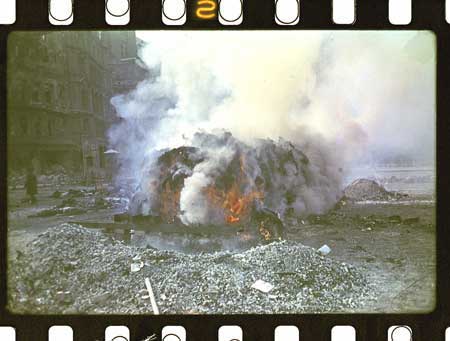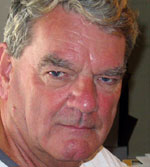DOCUMENTS ON THE DEATHROLL IN THE DRESDEN AIR RAIDS 1945
SO MANY innocents were killed in the 1945 British air raid on Dresden that the German authorities had to cremate the bodies on mass funeral pyres on the Altmarkt. Mr Irving was the first to publish these photographs in the west. When he produced one of them, enlarged to poster size, in Court, Defence Counsel Richard Rampton sneered, "So what!"
Letter from Dr Max Fünfack, Urologist, Dresden, January 19, 1965 to David Irving. Dear Mr Irving, You were so exceedingly kind as to send to my wife a copy of your book about The Destruction of Dresden, as printed matter. The book has arrived safely and we thank you very much for that. You can understand that as an old Dresdener who has been resident here for many generations, I have a particular interest in the event 20 years ago which I had to be more or less directly a participant in. I was bombed-out 100% at that time, in Surgery, Clinic and private residence and hall. I had to begin again after 1945 as a beggar. Thank God, nobody in my family was killed in it, because every member of it was outside Dresden when this air raid broke across Dresden. I was at that time the Chief Doctor of the Urological Department of the Military Reserve Hospital in Dresden-Neustadt, and I was taken by surprise by the attack, in my home in Parkstrasse. It was pure chance that I survived, as I took refuge in the Red Cross Building in Tiergarten Strasse. All my neighbours in Parkstrasse were killed, without exception. It is unclear to me why I am now, after 20 years, being cast into the limelight by being named in the newspapers of the [West German] Federal Republic and why I am cited as a witness for the deathroll. Just like any other person affected I learned the figures only at third hand -- from the City Commandant who was my friend, from the Civil Air Defence, etc. But the figures were always substantially different. I myself was only once on the Altmarkt during the cremations, otherwise I was completely uninvolved. Nor was I ever the Medical Officer of Dresden or Deputy Medical Officer, but just active as a Urological Specialist in the Military Hospital. How you reached such a conclusion is completely incomprehensible to me. I have not had the least to do with such official bodies. The photographs of the cremations on the Altmarkt, and the "Tagesbefehl No 47" were also given to me by acquaintances. While I cannot make any binding statements on the deathroll I can only repeat what was reported to me. The City Commandant, General Mehnert, spoke on about 22 February 1945 of 140,000 dead, Professor Fetscher of the Civil Air Defence of 180,000. But I have never seen written evidence. I attach great importance to these facts, in order to serve the interests of the truth. The best informed ought really to be the delegates of the International Red Cross, who under the leadership of a Swiss, were provided with all the figures when they came on about 22-26 February to enquire about the prisoners of war, as was their duty. Unfortunately, I do not know their names, but I was together with them shortly at one meeting. Allow me once more in the name of and on the instructions of my wife, and in my own name, to state my thanks for having sent this interesting book. I would just be curious to know how you came into possession of my name and address. Yours faithfully, M. Fünfack PS: I learned of the naming of my name in the Press from a Mr Nicolaus of the Ideological Commission of the SED [Socialist Unity Party, the governing Communist party] and the City Management in Dresden. Letter from Dr Max Fünfack, Urologist, Dresden, March 16, 1965 to David Irving. Dear Mr Irving, Very many thanks for your thank you letter from Madrid dated February 20, 1965 which came into my hands after being rubberstamped by the Dresden Postal Customs Office on the envelope. It has put me in a most unpleasant situation that my name has appeared in the Press of the Federal Republic, and that naturally also the appropriate Authorities in our German Democratic Republic have learned of that. On account of this fact I was subjected to several interrogations and had above all, in accordance with the truth, to state correctly that I was never here the Medical Officer or the Deputy Medical Doctor. It is completely incomprehensible how anybody came to this conclusion. It is also a puzzle to me how even my name became known. I was just more or less an observer of the air raid and gravely affected by it, and had no kind of official function e.g., in the counting of the dead. It would interest me to know how my name was dug up. You will certainly understand that I attach great importance to this so that I am spared further such interrogations that just cost me my free time and cause me a lot of aggravation. For that reason I will have a copy made of the mentioned order of the day Tagesbefehl No. 47 and send it to you [this sentence was poorly legible]. I want nothing to do with this. I can answer a few questions. Lieutenant General Karl Mehnert was City Commandant of Dresden and was a very close friend of mine. I was very often together with him. He was truly no Hitler fan and for this reason I liked him particularly. In May 1945, he ended up in Russian captivity and he lived for many years after his return from Russia in Dresden. In this time too we were often together. In about 1955 he went to Wiesbaden, and died there years later aged about 73. With him I naturally often talked about the air-raid and we spoke about the death roll. We were both astonished about the tiny figure of 35,000 which was given out in the Press here. Professor Dr. Fetscher (ret.) had his medical practice quite close to mine. He was a convinced Anti-Fascist, and knew of deathtoll figures in the magnitude of which I made mention and wrote to you. In May 1945 he was shot by the SS in Dresden's Prager Strasse, as he was about to drive out to meet the Soviet army with a white flag. 
I received the Tagesbefehl which I mentioned, to the best of my memory, in the military reserve hospital No.1 merely through official channels. I was at that time the Chief of the Urological Department and Oberstabsarzt [major in Army medical corps]. If you ever come here, then I will show you my copy willingly, on condition that the proper Authorities here are informed of this, and are in agreement with it. It would be impossible for me to send it by post. I never kept a diary. A short time ago a book by [Walter] Weidauer was published here "Inferno Dresden", where once more only the 35,000 figure is given. You will have to read that one day. Many thanks also for having sent me the very pretty photos of your family which pleased us very much. I was present for only a relatively short time during the cremations on the Altmarkt, on the occasion of visiting my completely bombed-out clinic and surgery in the town centre in the Garnisonen Strasse. Everything had been cordoned off. I was only able to get in wearing the uniform of an Oberstabsarzt. I do not want to write to you any more about it than that. If you come to Dresden, I would look forward to your visit. Yours faithfully, M. Fünfack Key. In our opinion green passages are attempts by Fünfack to minimise his 1945 role, and are written for the benefit of the 1965 Communist postal censors. Red passages are the real burden of the letters. |

